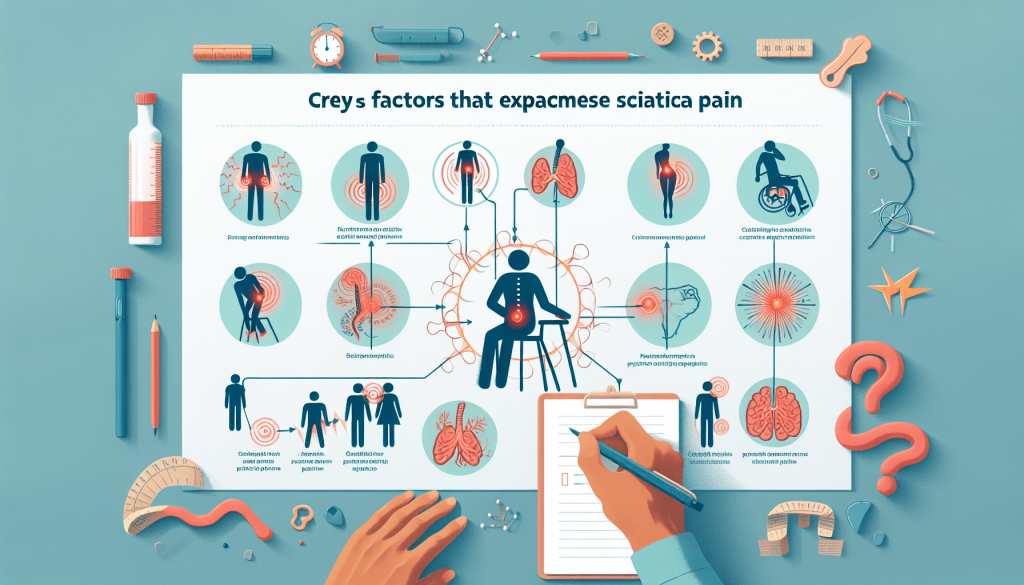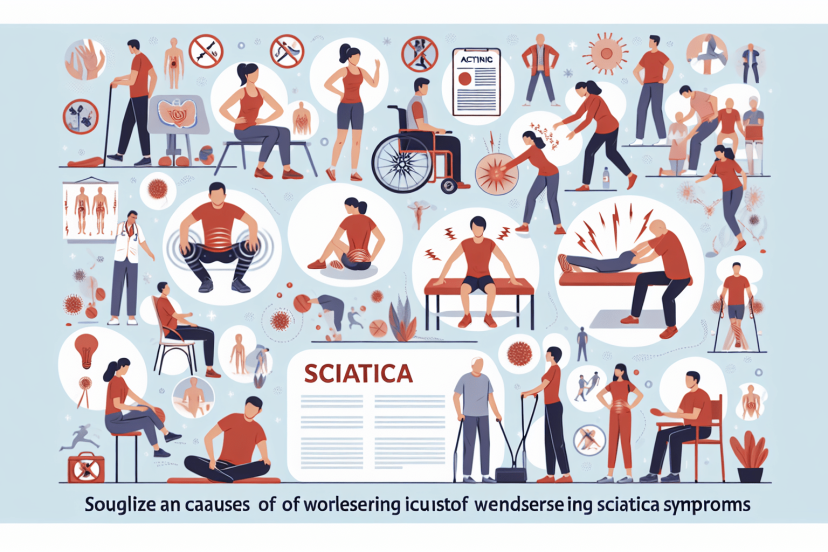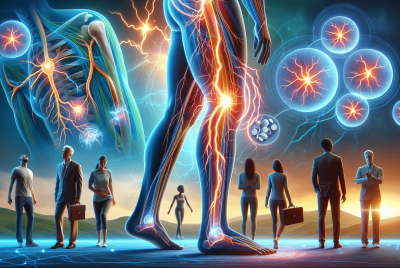What Makes Sciatica Worse?
Have you ever wondered what factors can worsen the debilitating pain of sciatica? In this article, we will explore the various triggers that can aggravate sciatica symptoms, leaving you in pain and discomfort. Understanding these potential culprits can help you make appropriate lifestyle changes to manage and alleviate the effects of this troublesome condition. So, let’s delve into the world of sciatica triggers and discover how to minimize its impact on your daily life.

What Makes Sciatica Worse?
Sitting Positions
Sitting for long periods
Sitting for long periods of time can worsen sciatica symptoms. When you sit for extended periods, especially in a slouched or hunched position, it puts pressure on the sciatic nerve. This pressure can lead to increased pain and discomfort in the lower back, buttocks, and legs. So, if you have sciatica, it’s important to take regular breaks from sitting and avoid sitting for long periods without proper support.
Sitting with poor posture
Maintaining poor posture while sitting can aggravate sciatica symptoms. Slouching or arching your back puts additional stress on the spine and compresses the sciatic nerve. It is essential to sit upright with good posture, ensuring that your back is aligned with the chair and your feet are flat on the ground. Using a lumbar support cushion or an ergonomic chair can help promote proper posture and reduce the strain on your sciatic nerve.
Lack of Physical Activity
Sedentary lifestyle
Living a sedentary lifestyle, where physical activity is limited, can make your sciatica worse. Lack of movement and exercise can lead to muscle stiffness and weakness, which can contribute to increased pain and discomfort. Engaging in regular physical activity, like walking, swimming, or gentle stretching exercises, can help improve blood circulation, strengthen muscles, and alleviate sciatica symptoms.
Lack of exercise
Similar to a sedentary lifestyle, not participating in regular exercise can exacerbate sciatica symptoms. Lack of exercise can lead to muscle imbalances and reduced flexibility, which can put additional strain on the sciatic nerve. Incorporating exercises that specifically target the muscles supporting the spine, such as yoga or Pilates, can help alleviate sciatica pain and prevent further aggravation.
Muscle weakness
Muscle weakness, particularly in the core and lower back muscles, can contribute to sciatic nerve compression and increased pain. Weak muscles are unable to provide adequate support to the spine, making it more susceptible to injuries and nerve impingement. Strengthening exercises, such as core and back exercises, can help improve muscle strength and stability, reducing the chances of worsening sciatica symptoms.
Incorrect Lifting Techniques
Bending and lifting heavy objects incorrectly
Using incorrect lifting techniques can put strain on the back muscles and lead to sciatica pain. When lifting heavy objects, it is crucial to bend your knees and use your leg muscles instead of relying solely on your back. Failing to do so can result in undue pressure on the sciatic nerve, causing or worsening sciatica symptoms. Always maintain a straight back and lift with your legs to minimize the risk of injury.
Twisting while lifting
Twisting your body while lifting heavy objects can significantly increase the likelihood of aggravating your sciatica. Twisting adds an extra strain on the lower back, potentially compressing the sciatic nerve and causing excruciating pain. To avoid this, it’s essential to face the object you are lifting, pivot your feet instead of twisting your torso, and lift in a controlled and steady manner.
Straining back muscles
Overexerting your back muscles can lead to strained muscles, which can exacerbate sciatica symptoms. Activities such as heavy lifting, repetitive motions, or sudden movements can strain the muscles supporting the spine. It is crucial to listen to your body, avoid overstraining your back, and take breaks when necessary. If you already have sciatica, it’s especially important to be mindful of your movements and avoid activities that may strain your back muscles.
Excessive Weight or Obesity
Extra weight putting pressure on the spine
Carrying excess weight can place additional pressure on the spine, worsening sciatica symptoms. The increased load on the spine can compress the sciatic nerve, causing pain, numbness, and tingling in the lower back and legs. Losing weight through a healthy diet and regular exercise can relieve this pressure and alleviate sciatica symptoms.
Increased risk of disc herniation
Obesity and excessive weight can also increase the risk of intervertebral disc herniation, a common cause of sciatica. Excess body weight puts added stress on the spinal discs, making them more susceptible to bulging or herniation. When a herniated disc presses on the sciatic nerve, it can result in severe sciatica pain. By maintaining a healthy weight, you can reduce the risk of disc herniation and minimize sciatica symptoms.

Smoking
Reduced blood flow to the spinal discs
Smoking cigarettes can have adverse effects on your spinal health, including the worsening of sciatica symptoms. Smoking restricts blood flow to the spinal discs, impeding their ability to receive essential nutrients and oxygen. This reduced blood flow can lead to disc degeneration and inflammation, which can exacerbate sciatica pain. Quitting smoking can help improve blood circulation and promote healing within the spinal discs.
Increased risk of disc degeneration
In addition to compromising blood flow, smoking also increases the risk of premature disc degeneration. The chemicals in cigarettes can accelerate the breakdown of the spinal discs, making them more prone to wear and tear. As the discs degenerate, they can bulge and irritate the sciatic nerve, leading to more intense sciatica pain. Quitting smoking not only benefits your overall health but can also have a positive impact on your sciatica symptoms.
Prolonged Driving
Driving long distances without breaks
Long hours of driving without taking breaks can worsen sciatica symptoms. Staying seated in one position for an extended period, especially without proper lumbar support, can strain the lower back and compress the sciatic nerve. It’s essential to take regular breaks during long drives, stretch your legs, and perform gentle exercises to promote blood circulation and alleviate any discomfort.
Sitting in an uncomfortable position
Sitting in an uncomfortable position while driving, such as hunching over the steering wheel or having inadequate seat support, can aggravate sciatica pain. It’s crucial to adjust your seat and steering wheel to maintain a neutral posture that supports your back. Using lumbar support pillows or cushions can provide additional comfort and help relieve pressure on the sciatic nerve while driving.
High-Impact Activities
Running on hard surfaces
High-impact activities, like running on hard surfaces, can worsen sciatica symptoms. The repeated pounding of the feet on a hard surface can jar the spine and compress the sciatic nerve. Opting for low-impact exercises, such as swimming or cycling, can provide cardiovascular benefits without placing excessive strain on the lower back and sciatic nerve.
Participating in contact sports
Contact sports that involve physical collisions or abrupt movements can increase the risk of worsening sciatica symptoms. The sudden impact or twisting motions can irritate the sciatic nerve and lead to intense pain. If you have sciatica, it’s advisable to avoid or modify activities that involve direct contact or rapid changes in direction to prevent further aggravation.
Poor Mattress or Sleeping Position
Sleeping on a worn-out mattress
Sleeping on a worn-out or unsupportive mattress can contribute to sciatica pain. An old mattress may sag in certain areas, resulting in an uneven sleeping surface that strains the lower back and aggravates the sciatic nerve. Investing in a supportive mattress that promotes proper spinal alignment can significantly alleviate sciatica symptoms and improve the quality of your sleep.
Sleeping in an unnatural position
Sleeping in an unnatural position, such as on your stomach or in a twisted posture, can worsen sciatica pain. These sleeping positions can place unnecessary strain on the spine, leading to increased pressure on the sciatic nerve. It is recommended to sleep on your side with a pillow between your knees or on your back with a pillow supporting your lower back. These positions help maintain the natural curves of the spine and reduce the likelihood of sciatica flare-ups.
Psychological Stress
Increased muscle tension
Psychological stress can manifest physically as increased muscle tension, which can exacerbate sciatica symptoms. When you are stressed, your muscles tend to tighten up, including those supporting the spine. This increased muscle tension can compress the sciatic nerve and intensify pain. Engaging in stress-reducing activities, such as meditation, deep breathing exercises, or yoga, can help relax the muscles and alleviate sciatica-related discomfort.
Heightened pain perception
Stress and anxiety can also affect how you perceive pain, making sciatica symptoms feel more severe than they actually are. Psychological stressors can amplify the pain signals from the sciatic nerve, leading to heightened pain perception. It’s essential to find healthy coping mechanisms for stress, such as therapy, exercise, or engaging in enjoyable hobbies, to manage your psychological well-being and reduce the impact on your sciatica symptoms.
Certain Medical Conditions
Spinal stenosis
Spinal stenosis, a condition characterized by the narrowing of the spinal canal, can worsen sciatica symptoms. The narrowed space puts pressure on the spinal cord and nerves, including the sciatic nerve. This compression can result in severe sciatica pain, numbness, and weakness. Proper diagnosis and targeted treatment for spinal stenosis are necessary to manage the underlying condition and alleviate sciatica symptoms.
Spondylolisthesis
Spondylolisthesis, a condition where one vertebra slips forward over the adjacent vertebra, can contribute to sciatica pain. The displacement of the vertebra can compress the sciatic nerve, causing radiating leg pain and other associated symptoms. Treatment options for spondylolisthesis, including physical therapy and, in severe cases, surgery, can help stabilize the spine and relieve sciatica symptoms.
Pregnancy
During pregnancy, hormonal changes and the growing baby can increase the risk of developing or worsening sciatica symptoms. The growing uterus and the additional weight can put pressure on the sciatic nerve, leading to radiating pain and discomfort. Gentle exercises, prenatal yoga, and practicing good posture can help manage sciatica during pregnancy. It’s essential to consult a healthcare professional to ensure safe and effective management.
Occupational hazards
Certain occupations that involve repetitive bending, lifting, or prolonged sitting can exacerbate sciatica symptoms. Jobs requiring repetitive movements or poor ergonomics can strain the lower back and compress the sciatic nerve. Implementing proper body mechanics, using supportive equipment, and taking regular breaks can help reduce the risk of worsening sciatica symptoms in the workplace.
It is important to remember that each individual’s experience with sciatica may vary. Consulting with a healthcare professional for an accurate diagnosis and personalized treatment plan is essential for effectively managing and alleviating sciatica symptoms. By being aware of the factors that can worsen sciatica, you can make informed lifestyle choices and modifications to minimize discomfort and promote overall spinal health.




